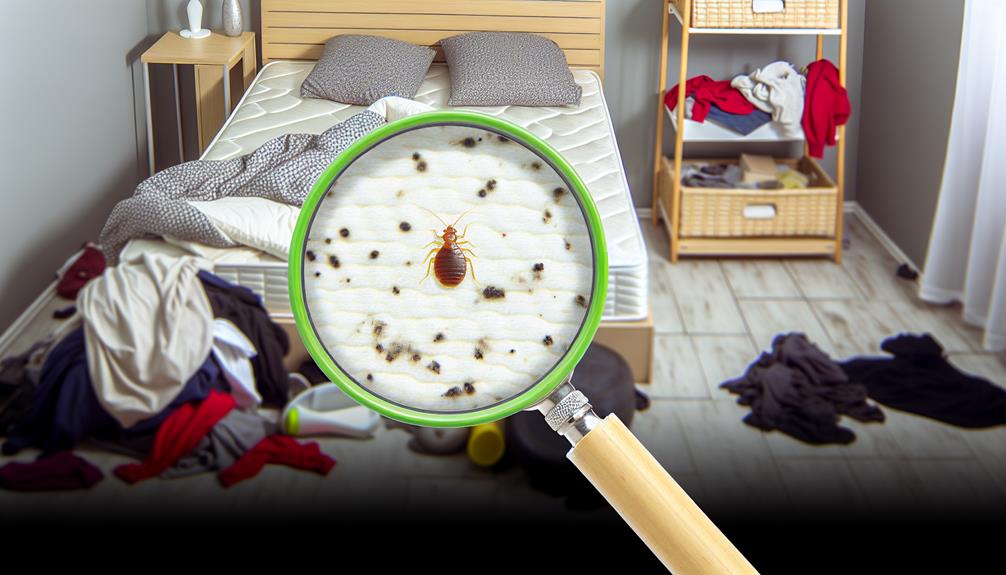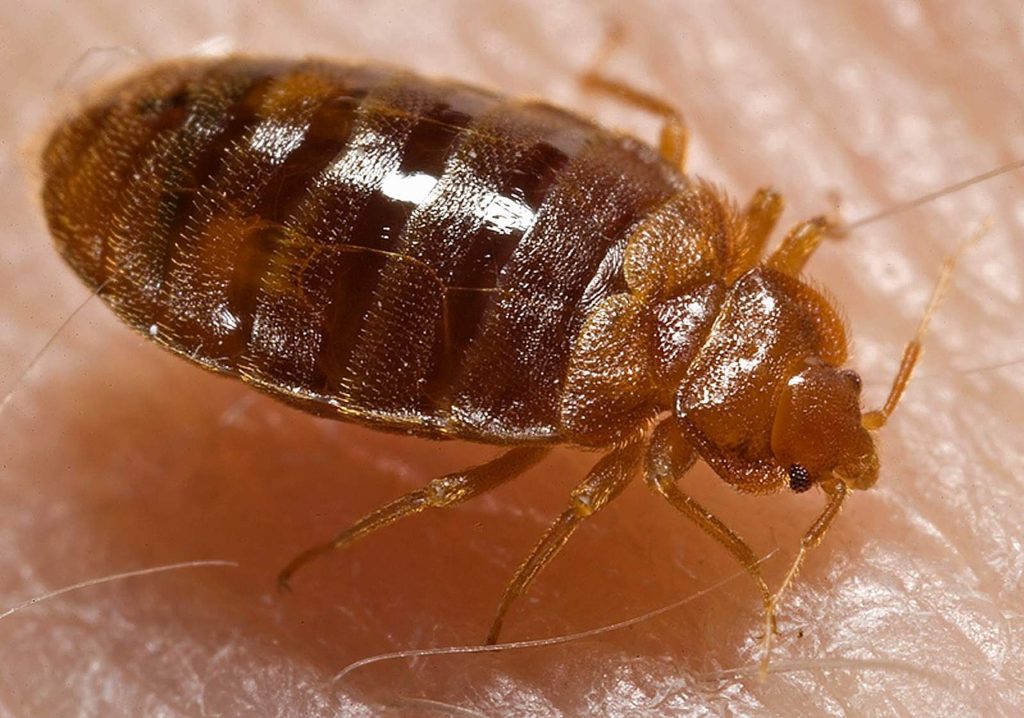Do Bed Bugs Go Away on Their Own
If you’ve noticed a few bed bugs in your home, you might hope they disappear without intervention. However, the reality is that bed bugs rarely vanish on their own. Their survival mechanisms are designed to withstand time and adversity, requiring proactive measures to address the issue effectively. Understanding the reasons behind their persistence can shed light on the importance of taking action sooner rather than later. The next steps you take could determine the outcome of this unwelcome situation.

Key Takeaways
- Bed bugs do not go away on their own.
- Their rapid reproduction requires intervention.
- Professional help is often needed for eradication.
- Untreated infestations can worsen health risks.
- Immediate action is crucial to prevent further spread.
Bed Bugs’ Reproductive Capabilities
Do bed bugs have the ability to reproduce rapidly, leading to infestations that are difficult to eradicate?
Bed bugs indeed possess remarkable capabilities for rapid reproduction, making them a significant challenge for population control. These blood-sucking parasites can lay up to 500 eggs in their lifetime, with each female capable of producing 1-5 eggs per day.
The ability to reproduce quickly, coupled with their resilience to various environmental conditions, enables bed bug populations to grow rapidly, overwhelming infested areas.
Resource management plays a vital role in the reproductive success of bed bugs. These insects can survive for months without feeding, strategically conserving resources to guarantee their survival in between meals. Once a suitable host is found, bed bugs waste no time in mating and laying eggs, perpetuating the infestation cycle.
The consequences of unchecked infestations are dire, with populations spiraling out of control and becoming increasingly challenging to eliminate. Effective strategies for population control must take into account the rapid reproductive capabilities of bed bugs to prevent widespread infestations.
Survival Instincts of Bed Bugs
Bed bugs exhibit a range of survival instincts that contribute to their ability to thrive and persist in various environments. These pests are nocturnal and have adapted feeding habits that allow them to obtain blood meals from hosts without being easily detected. Bed bugs are capable of surviving for several months without feeding, enabling them to endure periods of starvation until a suitable host is available. Their behavior includes aggregating in groups, which aids in reproduction and protection, enhancing their chances of survival.
Essential hiding spots are vital for bed bugs’ survival instincts. They tend to seek refuge in cracks, crevices, and other secluded areas near their hosts’ sleeping quarters. These hiding spots provide protection from potential threats and contribute to their ability to remain undetected.
Additionally, bed bugs exhibit migration patterns, moving between different locations to find new hosts and establish infestations in various areas. Understanding these survival instincts is essential for effectively managing and controlling bed bug infestations.
Lack of Natural Predators
Key predators of bed bugs are conspicuously absent, contributing to the challenges in controlling and managing their populations effectively. Without natural predators to keep their numbers in check, bed bugs can multiply rapidly and infestations can escalate. This lack of natural enemies means that other methods, such as holistic remedies, become essential in controlling bed bug populations.
Holistic remedies like diatomaceous earth, essential oils, and heat treatments are commonly used to combat bed bug infestations in the absence of natural predators. While these methods can be effective in reducing bed bug numbers in the short term, their long-term effects are limited due to the continual reproduction and resilience of bed bugs.
The absence of natural predators not only complicates the management of bed bug populations but also highlights the importance of implementing thorough strategies that consider both short-term control and long-term prevention measures.
As researchers continue to study bed bug behaviors and develop new control tactics, the impact of the lack of natural predators remains a significant factor in the ongoing battle against these persistent pests.

Bed Bugs’ Resistance to Pesticides
The increasing resistance of bed bugs to pesticides poses a significant challenge in effectively controlling their populations. Pesticide resistance refers to the decreased susceptibility of bed bugs to the effects of commonly used insecticides. This phenomenon has been observed in various regions worldwide and is a growing concern for pest management professionals.
As bed bugs develop resistance to pesticides, infestation levels can surge, making eradication efforts more difficult. In some cases, over-the-counter insecticides may no longer be effective in eliminating bed bug infestations. This resistance can lead to prolonged infestations, causing distress and discomfort for affected individuals.
To combat this issue, seeking professional help is often necessary. Pest control experts have access to a range of treatment options that can effectively target pesticide-resistant bed bug populations. These bed bug control professionals can conduct thorough inspections, identify the extent of the infestation, and implement appropriate strategies to manage and eliminate the bed bug problem.
Professional intervention is crucial in dealing with pesticide-resistant bed bugs and ensuring successful eradication of infestations.
Bed Bugs’ Ability to Hide
How effectively can bed bugs conceal themselves in various environments?
Bed bugs are adept at hiding, making it challenging to detect and eliminate them completely. Here are some insights into their hiding behavior and methods for eradication:
- Cracks and Crevices: Bed bugs have a preference for tight spaces, such as cracks in walls, baseboards, and furniture. These spots provide them with shelter during the day, allowing them to remain undetected.
- Textile Materials: These pests often hide in seams, folds, and creases of mattresses, beddings, and upholstered furniture. Their flat bodies enable them to squeeze into these small spaces, making it difficult to spot them.
- Electronics and Clutter: Bed bugs can also hide in electronics, behind picture frames, and amidst clutter. Their ability to conceal themselves in various household items adds to the challenge of eliminating them effectively.
To combat bed bugs, a combination of household remedies like vacuuming and washing bedding along with professional treatment may be necessary for a thorough approach to eradication.
Impact of Untreated Infestations
Untreated bed bug infestations can have significant repercussions on both human health and psychological well-being. When left unchecked, these pests can pose serious health risks. Bed bugs are known to cause skin irritation, allergic reactions, and in some cases, infections due to scratching. Additionally, the psychological toll of living with a bed bug infestation can lead to increased stress, anxiety, and sleep disturbances.
In addition to health concerns, untreated bed bug infestations can also result in property damage. Bed bugs can hide in various furniture and household items, leading to infested belongings needing to be discarded to eradicate the problem. The cost of replacing furniture, mattresses, and other infested items can add up significantly.
Furthermore, the longer the infestation persists, the more extensive the property damage can become, potentially affecting walls, carpets, and other structural elements of the home. Addressing bed bug infestations promptly is important to mitigate these health risks and prevent property damage.
Environmental Factors Favoring Bed Bugs
Environmental factors play a key role in creating conditions that are conducive to the proliferation of bed bugs within indoor spaces. Understanding these factors can help in managing and preventing infestations.
Here are three important environmental factors that favor bed bugs:
- Temperature Regulation: Bed bugs thrive in environments with temperatures between 70-80°F (21-27°C). These temperatures provide an ideal setting for their development and reproduction. Fluctuations outside this range can impact their growth and survival rates.
- Humidity Levels: Bed bugs prefer environments with humidity levels between 70-80%. High humidity aids in their growth and molting processes. However, extremely low humidity can also affect their survival. Proper humidity control is essential to discourage bed bug infestations.
- Environmental Stability: Bed bugs are sensitive to drastic environmental changes. Maintaining a stable environment regarding temperature and humidity can promote the longevity of bed bug populations. Sudden fluctuations may disrupt their feeding and breeding patterns, potentially reducing their numbers.

Bed Bugs’ Prolonged Lifespan
A bed bug’s lifespan can extend from several months to over a year under favorable environmental conditions. This longevity presents challenges for controlling infestations, as bed bugs have the ability to survive for extended periods without feeding. Their resilience contributes to the establishment of self-sustaining populations in various settings, making eradication efforts difficult.
Bed bugs’ prolonged lifespan allows them to adapt to changing conditions, enabling them to thrive in diverse environments. Their ability to survive without feeding for several months enhances their resilience, making complete eradication a complex task. These longevity challenges highlight the importance of thorough pest management strategies that target not only adult bed bugs but also their eggs and nymphs to prevent the establishment of self-sustaining populations.
Understanding the extended lifespan of bed bugs is important for developing effective control measures that can address infestations comprehensively. By considering the factors that contribute to their longevity and ability to sustain populations, it becomes possible to implement strategies that target all stages of the bed bug life cycle, ultimately leading to more successful eradication outcomes.
Bed Bugs’ Tendency to Spread
Bed bugs demonstrate a remarkable propensity for rapid dissemination within infested areas. Once bed bugs find their way into a location, they can quickly multiply and spread throughout various hiding spots. This rapid infestation can make it challenging to control their numbers effectively.
Here are three key factors contributing to bed bugs’ tendency to spread:
- Rapid Infestation: Bed bugs reproduce quickly, with females laying hundreds of eggs in their lifetime. This rapid reproductive rate allows their populations to grow exponentially within a short period, leading to widespread infestations.
- Uncontrollable Spread: Due to their elusive nature and ability to hide in cracks, crevices, and furniture, bed bugs can easily move between rooms and properties. This makes it difficult to contain and eradicate them completely, resulting in their persistent presence.
- Persistent Presence: Bed bugs have a knack for establishing hidden populations, making it hard to detect and eliminate every single bug. Their ability to stay hidden for extended periods contributes to their resilience and the challenges associated with eradicating them effectively.
© 2024 By Pest Control Irving TX Pros
